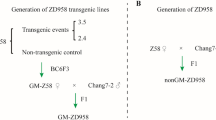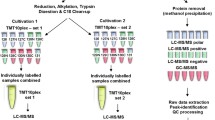Abstract
Key message
Non-targeted metabolomics analysis revealed only intended metabolic changes in transgenic maize over-expressing the Aspergillus niger phyA2.
Abstract
Genetically modified (GM) crops account for a large proportion of modern agriculture worldwide, raising increasingly the public concerns of safety. Generally, according to substantial equivalence principle, if a GM crop is demonstrated to be equivalently safe to its conventional species, it is supposed to be safe. In this study, taking the advantage of an established non-target metabolomic profiling platform based on the combination of UPLC-MS/MS with GC–MS, we compared the mature seed metabolic changes in transgenic maize over-expressing the Aspergillus niger phyA2 with its non-transgenic counterpart and other 14 conventional maize lines. In total, levels of nine out of identified 210 metabolites were significantly changed in transgenic maize as compared with its non-transgenic counterpart, and the number of significantly altered metabolites was reduced to only four when the natural variations were taken into consideration. Notably, those four metabolites were all associated with targeted engineering pathway. Our results indicated that although both intended and non-intended metabolic changes occurred in the mature seeds of this GM maize event, only intended metabolic pathway was found to be out of the range of the natural metabolic variation in the metabolome of the transgenic maize. Therefore, only when natural metabolic variation was taken into account, could non-targeted metabolomics provide reliable objective compositional substantial equivalence analysis on GM crops.



Similar content being viewed by others
References
Alimentarius C (2003) Guideline for the conduct of food safety assessment of foods derived from recombinant-DNA plants. CAC/GL 45:1–18
Baker JM, Hawkins ND, Ward JL, Lovegrove A, Napier JA, Shewry PR, Beale MH (2006) A metabolomic study of substantial equivalence of field-grown genetically modified wheat. Plant Biotechnol J 4:381–392
Barros E, Lezar S, Anttonen MJ, van Dijk JP, Röhlig RM, Kok EJ, Engel KH (2010) Comparison of two GM maize varieties with a near-isogenic non-GM variety using transcriptomics, proteomics and metabolomics. Plant Biotechnol J 8:436–451
Berger DC, Hilton MA, Hilton FK, Duncan SD, Radmacher PG, Greene SM (1996) Intravenous gamma-glutamyl-tyrosine elevates brain tyrosine but not catecholamine concentrations in normal rats. Metabolism 45:126–132
Bovy AG, Gómez-Roldán V, Hall RD (2010) Strategies to optimize the flavonoid content of tomato fruit. In: Santos-Buelga C, Escribano-Bailon M, Lattanzio V (eds) Recent Advances in Polyphenols Research, Wiley-Blackwell, Ames, USA, pp 138–162
Chen R, Xue G, Chen P, Yao B, Yang W, Ma Q, Fan Y, Zhao Z, Tarczynski MC, Shi J (2008) Transgenic maize plants expressing a fungal phytase gene. Transgenic Res 17:633–643
Clarke JD, Alexander DC, Ward DP, Ryals JA, Mitchell MW, Wulff JE, Guo L (2013) Assessment of genetically modified soybean in relation to natural variation in the soybean seed metabolome. Sci Rep 3:3082
Coll A, Nadal A, Collado R, Capellades G, Kubista M, Messeguer J, Pla M (2010) Natural variation explains most transcriptomic changes among maize plants of MON810 and comparable non-GM varieties subjected to two N-fertilization farming practices. Plant Mol Biol 73:349–362
Dlugosch KM, Whitton J (2008) Can we stop transgenes from taking a walk on the wild side? Mol Ecol 17:1167–1169
Evans AM, DeHaven CD, Barrett T, Mitchell M, Milgram E (2009) Integrated, nontargeted ultrahigh performance liquid chromatography/electrospray ionization tandem mass spectrometry platform for the identification and relative quantification of the small-molecule complement of biological systems. Anal Chem 81:6656–6667
FAO/WHO (2000) Safety aspects of genetically modified foods of plant origin. Report of a Joint FAO/WHO Expert Consultation on Foods Derived from Biotechnology, World Health Organization, Geneva
Frank T, Röhlig RM, Davies HV, Barros E, Engel KH (2012) Metabolite profiling of maize kernels–genetic modification versus environmental influence. J Agric Food Chem 60:3005–3012
Garcia FAA (2012) Tests to identify outliers in data series. http://cn.mathworks.com/matlabcentral/fileexchange/28501-tests-to-identify-outliers-in-data-series. Pontifical Catholic University of Rio de Janeiro, Industrial Engineering Department, Rio de Janeiro, Brazil
García-Cañas V, Simó C, León C, Ibáñez E, Cifuentes A (2011) MS-based analytical methodologies to characterize genetically modified crops. Mass Spectrom Rev 30:396–416
Gayen D, Sarkar SN, Datta SK, Datta K (2013) Comparative analysis of nutritional compositions of transgenic high iron rice with its non-transgenic counterpart. Food Chem 138:835–840
Gechev TS, Hille J (2012) Molecular basis of plant stress. Cell Mol Life Sci 69:33161–33163
Gupta KK, Bhattacharjee S, Kar S, Chakrabarty S, Thakur P, Bhattacharyya G, Srivastava SC (2003) Mineral compositions of eight common spices. Commu Soil Sci Plant 34:681–693
Harrigan GG, Chassy B (2012) Challenges for metabolomics as a tool in safety assessments. In: Roessner U (ed) Metabolomics Regulatory Product Characterization and Safety Center, Monsanto Co., St. Louis, MO
Harrigan GG, Stork LG, Riordan SG, Reynolds TL, Ridley WP, Masucci JD, Macisaac S, Halls SC, Orth R, Smith RG, Wen L, Brown WE, Welsch M, Riley R, McFarland D, Pandravada A, Glenn KC (2007) Impact of genetics and environment on nutritional and metabolite components of maize grain. J Agric Food Chem 55:6177–6185
Harrigan GG, Lundry D, Drury S, Berman K, Riordan SG, Nemeth MA, Ridley WP, Glenn KC (2010) Natural variation in crop composition and the impact of transgenesis. Nat Biotechnol 28:402–404
Herman RA, Storer NP, Phillips AM, Prochaska LM, Windels P (2007) Compositional assessment of event DAS-59122-7 maize using substantial equivalence. Regul Toxicol Pharmacol 47:37–47
Hitz WD, Carlson TJ, Kerr PS, Sebastian SA (2002) Biochemical and molecular characterization of a mutation that confers a decreased raffinosaccharide and phytic acid phenotype on soybean seeds. Plant Physiol 128:650–660
Iwaki T, Guo L, Ryals JA, Yasuda S, Shimazaki T, Kikuchi A, Watanabe KN, Kasuga M, Yamaguchi-Shinozaki K, Ogawa T, Ohta D (2013) Metabolic profiling of transgenic potato tubers expressing Arabidopsis Dehydration Response Element-Binding Protein 1A (DREB1A). J Agric Food Chem 61:893–900
James C (2014) Global status of commercialized biotech/GM Crops: 2014 Executive summary. ISAAA Brief No. 49. ISAAA: Ithaca, NY
Kameyama K, Kishi Y, Yoshimura M, Kanzawa N, Sameshima M, Tsuchiya T (2000) Tyrosine phosphorylation in plant bending. Nature 407:37
Karner U, Peterbauer T, Raboy V, Jones DA, Hedley CL, Richter A (2004) myo-Inositol and sucrose concentrations affect the accumulation of raffinose family oligosaccharides in seeds. J Exp Bot 55:1981–1987
Kuiper HA, Kleter GA, Noteborn HP, Kok EJ (2001) Assessment of the food safety issues related to genetically modified foods. Plant J 27:503–528
Kusano M, Redestig H, Hirai T, Oikawa A, Matsuda F, Fukushima A, Arita M, Watanabe S, Yano M, Hiwasa-Tanase K, Ezura H, Saito K (2011) Covering chemical diversity of genetically-modified tomatoes using metabolomics for objective substantial equivalence assessment. PLoS One 6(2):e16989
Ladics GS, Budziszewski GJ, Herman RA, Herouet-Guicheney C, Joshi S, Lipscomb EA, McClain S, Ward JM (2014) Measurement of endogenous allergens in genetically modified soybeans—short communication. Regul Toxicol Pharm 70:75–79
McClain S, Jones W, He X, Ladics G, Bartholomaeus A, Raybould A, Lutter P, Xu H, Wang X (2015) Agricultural biotechnology safety assessment. Chinese J Prev Med 49:78–87
Montero M, Coll A, Nadal A, Messeguer J, Pla M (2011) Only half the transcriptomic differences between resistant genetically modified and conventional rice are associated with the transgene. Plant Biotechnol J 9:693–702
OECD (2002) Consensus document on compositional considerations for new varieties of Maize (Zea mays): key food and feed nutrients, anti-nutrients and secondary plant metabolites. Environmental Directorate: Joint meeting of Chemical Committee and the Working Party on Chemicals, Pesticides and Biotechnology: Series on the Safety of Novel Foods and Feeds No. 6. Paris, France
Ohta T, Masutomi N, Tsutsui N, Sakairi T, Mitchell M, Milburn MV, Ryals JA, Beebe KD, Guo L (2009) Untargeted metabolomic profiling as an evaluative tool of fenofibrate-induced toxicology in Fischer 344 male rats. Toxicol Pathol 37:521–535
Rahman K (2007) Studies on free radicals, antioxidants, and co-factors. Clin Interv Aging 2:219
Rao J, Yang L, Wang C, Zhang D, Shi J (2013) Digital gene expression analysis of mature seeds of transgenic maize overexpressing Aspergillus niger phyA2 and its non-transgenic counterpart. GM Crops Food 4:98–108
Rao J, Cheng F, Hu C, Quan S, Lin H, Wang J, Chen GH, Zhao XX, Alexander D, Guo LN, Wang GY, Lai JS, Zhang DB, Shi JX (2014) Metabolic map of mature maize kernels. Metabolomics 10:775–787
Ricroch AE, Bergé JB, Kuntz M (2011) Evaluation of genetically engineered crops using transcriptomic, proteomic, and metabolomic profiling techniques. Plant Physiol 155:1752–1761
Rocco M, Corrado G, Arena S, D’Ambrosio C, Tortiglione C, Sellaroli S, Marra M, Rao R, Scaloni A (2008) The expression of tomato prosystemin gene in tobacco plants highly affects host proteomic repertoire. J Proteomics 71:176–185
Schauzu M (2000) The concept of substantial equivalence in safety assessment of foods derived from genetically modified organisms. AgBiotechNet 2
Shepherd LV, McNicol JW, Razzo R, Taylor MA, Davies HV (2006) Assessing the potential for unintended effects in genetically modified potatoes perturbed in metabolic and developmental processes. Targeted analysis of key nutrients and anti-nutrients. Transgenic Res 15:409–425
Sitbon F, Ostin A, Sundberg B, Olsson O, Sandberg G (1993) Conjugation of indole-3-acetic acid (IAA) in wild-type and IAA-overprodcing transgenic tobacco plants, and identification of the main conjugates by Frit-Fast atom bombardment liquid chromatography-mass spectrometry. Plant Physiol 101:313–320
Skogerson K, Harrigan GG, Reynolds TL, Halls SC, Ruebelt M, Iandolino A, Pandravada A, Glenn KC, Fiehn O (2010) Impact of genetics and environment on the metabolite composition of maize grain. J Agric Food Chem 58:3600–3610
Stark DM, Timmerman KP, Barry GF, Preiss J, Kishore GM (1992) Regulation of the amount of starch in plant tissues by ADP glucose pyrophosphorylase. Science 258:287–292
Ueda M, Bandurski RS (1969) A quantitative estimation of alkali-labile indole-3-acetic acid compounds in dormant and germinating maize kernels. Plant Physiol 44:1175–1181
Wang L, Wang X, Jin X, Jia R, Huang Q, Tan Y, Guo A (2015) Comparative proteomics of Bt-transgenic and non-transgenic cotton leaves. Proteome Sci 13:15
Yang X, Staub J, Pandravada A, Riordan S, Yan Y, Bannon G, Martino-Catt S (2013) Omics technologies reveal abundant natural variation in metabolites and transcripts among conventional maize hybrids. Food Nutr Sci 4:335–341
Zhang D, Guo J (2011) The development and standardization of testing methods for genetically modified organisms and their derived products. J Integr Plant Biol 53:539–551
Acknowledgments
We thank Dr. Rumei Chen from China Academy of Agricultural Sciences for supplying the seeds of transgenic maize overexpressing Aspergillus niger phyA2 and its non-transgenic counterpart used in present study. We also thank Dr. Guorun Qu, Ms. Fang Cheng, Qian Luo, and Jing Zhou for their assistance in the metabolomic analysis. This work was supported by the China National Transgenic Plant Special Fund (2013ZX08012-002 and 2014ZX08012-002), and the Programme of Introducing Talents of Discipline to Universities (111 Project, B14016) to Dabing Zhang.
Author information
Authors and Affiliations
Corresponding author
Ethics declarations
Conflict of interest
The authors declare no conflict of interest.
Additional information
Communicated by M. C. Jordan.
Electronic supplementary material
Below is the link to the electronic supplementary material.
Rights and permissions
About this article
Cite this article
Rao, J., Yang, L., Guo, J. et al. Metabolic changes in transgenic maize mature seeds over-expressing the Aspergillus niger phyA2 . Plant Cell Rep 35, 429–437 (2016). https://doi.org/10.1007/s00299-015-1894-6
Received:
Revised:
Accepted:
Published:
Issue Date:
DOI: https://doi.org/10.1007/s00299-015-1894-6




